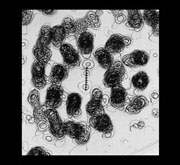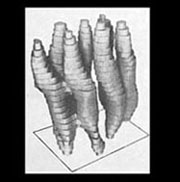Bacteriorhodopsin
Bacteriorhodopsin, in the cell membrane of the bacterium, Halobacterium Halobium, is a light-driven proton pump involved in photosynthesis. We obtained a 7Å three-dimensional map of this protein by applying the low-dose imaging method to tilted specimens, and combining the data obtained from the different views. The map revealed that bacteriorhodopsin contains seven α-helical segments extending roughly perpendicular to the plane of the membrane for most of its width. The helices pack closely together side-to-side, forming a left-handed supercoil.
Later structural studies showed that G-protein coupled receptors - the eukaryotic proteins responsible for a wide range of trans-membrane signalling processes - have a similar seven-α-helical design.
Key publication:
Henderson, R. and Unwin, P.N.T. Three-dimensional model of purple membrane obtained by electron microscopy. Nature 257, 28-32 (1975). (pdf)



